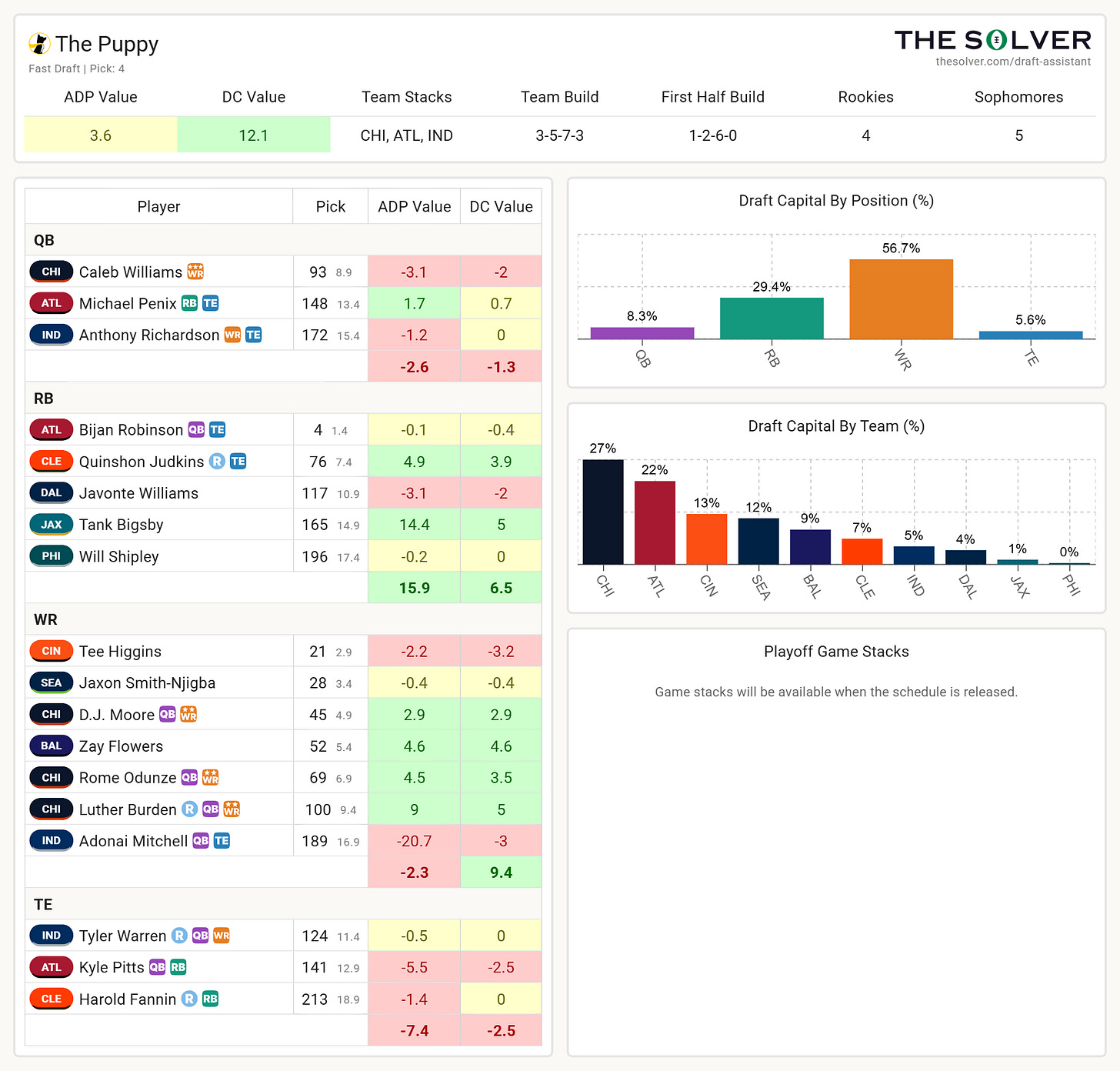Reviewing Establish The Run's Best Ball Draft Assistant
The good, the bad, and where we go from here
As I wrote in Top Lines the other day, my view has been that the Real Time Assistance best ball tools are a slight negative to best ball in the long-term, but are unlikely to meaningfully reduce the fun or edge in drafting in their current form. However, after trying out Establish The Run’s Draft Assistant on Underdog, I’d like to revise that statement, on both accounts, as well as provide my early opinions on the tool.
The Good
Saving Time and Increasing Convenience
I’ve enjoyed using Draft Assistant so far, and it’s already evident that it simplifies the process for drafters by reducing the number of things we have to keep track of in our heads. For example, after drafting CeeDee Lamb, Rashee Rice, and Courtland Sutton, I didn’t have to go star every Broncos player, or memorize those three teams/QBs for stack purposes. The tool simply auto-adjust the score and color-coded those factors for me. When it came time to decide whether to try to push Mahomes past ADP, the tool had already slightly upped the score/color for Bo Nix and Dak Prescott, enabling me to quickly decide to take the correlated value with a running back pick. In 20-second Puppy drafts, this is certain to be helpful, enabling us to maximize the amount of time we can spend on other aspects of my strategy, or for the true Best Ballers out there, draft multiple Puppys at once. Similarly, as expected, the Draft Assistant aids with slow drafts, as I don’t have to spend as much time getting up to speed on my strategy, starring players/teams, or re-naming teams to help myself acclimate quickly. So, from the fun/time/convenience aspect, I think the tool accomplishes its goals, and is will be useful for volume drafters.
Flagging Correlation
Draft Assistant goes a great job of helping you quickly find correlation, as it highlights a little positional icon next to the player’s name that flags whether you have the QB, RB, WR, or TE from the same team already, which is color-coded to Underdog’s positional colors. I haven't entered slow draft hell yet, but it’s easy to see how useful that aspect of the tool should be.
Balancing Rank/ADP Value with Correlation
Draft Assistant takes a strong stance on correlation, quickly bumping up the score for teammates of players you already drafted. For example, after selecting D.J. Moore, each of the Bears’ scores were bumped up relative to the players being drafted at similar ADPs. But, the tool also does well with balancing the ADP/rank value with the correlation, especially in the early rounds.
If there’s a significant rank/ADP faller, the tool will push to take that value instead of the stack, which is probably the correct decision in most cases. As an example, the tool strongly pushed me to select a falling Zay Flowers (ETR rank 40/ADP 47) at pick 52 instead of taking George Pickens (ETR 52/ADP 56), despite already having CeeDee Lamb on the team. I wanted to take Pickens, but I knew the “sharp” play was to take the value with Flowers, which the tool recognized as well.
Positional Balance and When To Push It
Arguably the most useful aspect of the tool so far has been helping me decide when to push a tactic another round, such as with stacking and positional needs, which matched my expectations. For example, in the team below, the tool identified Patrick Mahomes as a push candidate, as I could take a slight ADP value and still have multiple stacked outs at QB.1 Ultimately, I didn’t get Mahomes (the unstacked QB snipers strike again), but I did get a nice value on on Quinshon Judkins (who was correlated with Jerry Jeudy), and did get strong Cowboys + Broncos passing double stacks.
Similarly, the tool is great for identifying positional balance in the middle rounds, which is one of my weaknesses as a drafter, and one of the hardest things to consistently do well. From the 8th-13th round or so, I noticed that the tool was quickly switching between positions with the highest score, as it recognized that this team really needed QB and TE firepower. Once I had Nix and Dak, each of the tight ends scores shot up, but it didn’t want me to reach too far. As Najee Harris fell almost a round past ADP, his score continued to rise and ultimately came in ahead of the TEs with a lower rank/ADP behind them. After I selected Najee, the TEs scores shot back up.
Essentially, the tool recognized my need for tight end, but adjusted to recommend the falling ADP value, before pivoting hard back to the tight end position. This question of when to push a positional need further in order to capitalize on a value/correlation is often challenging, and I was very impressed with Draft Assistant’s ability to sort through it.
The Bad
Too Rank Reliant
While ETR’s ranks are almost certain to be better than raw ADP, I found Draft Assistant a bit too reliant on it so far. The tool should simply consider living a little, especially in the later rounds. As an example, ETR has Tutu Atwell at 171, which made him the max 10.0 in Solver Score in the last few rounds. While I’m a Tutu stan this year (with a big bag of shares from the pre-draft contests), his score was almost certainly overinflated relative to Troy Franklin, who was only between a 3 and a 5. While Tutu is a much better median bet than Franklin, I had Bo Nix and only one other Broncos pass-catcher, meaning Franklin should be a prime last-round pick candidate. Even if Tutu’s score was the highest, Franklin’s should have been high enough for him to at least be in consideration.
The ADP Value/Draft Capital Value doesn’t teach a man to fish
So, the tool recognizes that ADP value is not linear throughout the draft, (similar to the analysis I did with Travis Hunter based on Sam Hoppen’s work). It attempts to address this by providing a Draft Capital Value next to it, which I’m guessing is based on Mike Leone’s work from a year or two ago that was very similar to Sam’s. While I think that is super useful, it would be helpful if the explicit draft capital values were linked to or made clear as part of the methodology, as the post-draft summary doesn’t help us think through the draft capital value part during the draft. In my opinion, people often get too focused on ADP “value” in the second half of drafts, when in reality, a falling 14th round pick is only actually worth about 1/3 of the ADP value, as we see from Tank Bigsby in the team below. While I appreciate the inclusion of Draft Capital, I think the tool would be better if there was an element of teaching a man to fish with it during the draft.
Final Review and Where We Go From Here
Bottom line, after trying Draft Assistant, in the short-term I expect tools like this to:
Increase my enjoyment of drafts I do on my computer (especially slow drafts)
Slightly reduce the fun/competitiveness of drafts I do on my phone (especially those while I’m walking, though I get other non-monetary benefits there)
Slightly increase the average/median drafter score
Regarding the reduction in edge/increasing the level of competition, I think we should expect that effect to be very small in the short-term. The number of people paying for the tools will be probably be small (almost sub 25%2 ), and the vast majority of Underdog drafters probably draft from their phones (75%+)3. If you combine those two numbers, we should probably expect only 1-2 users per draft to be using tools, depending on time and contest.4 Because of that, I expect any potential reduction to edge/increase to level of competition to be slow and small. Even if you assume a tool is bumping median projection by 10%, if only 2 drafters are using it, we’re still only seeing an increase to overall median score of 1.5-2%.
However, while the increase in competition isn’t massive, no tool is going to forget which stacks it set up, or which team plays which in week 17, and it certainly is not going to be mid Cardio Club workout at any point during a draft. Plus, as many folks have said, as the tools become better, cheaper5, and more widely adopted, the impacts will be greater. While I empathize with that, and I enjoy best ball as much as each of you, that’s just the reality of games that are played for real money. There are ways to mitigate that without banning the overlay tools, such as having separate contests for mobile users/apps only, but make no mistake, we have been on the path towards losing our edge since the moment Underdog made best ball go mainstream.
So, let’s enjoy it while it lasts. As always, thanks for reading and best of luck drafting!
Though, I’m not entirely sure it factored in the multiple QB stack outs. It definitely had already bumped Dak and Nix’s score higher, but I’m not sure if it did the conditional solving of “If I miss on a pushed Mahomes, then I can still take Nix + Dak” that most sharp drafters would recognize.
Per Pete Overzet’s stream today, Underdog is planning to make a public statement on the overlay tools soon, and hopefully that will include a percentage of mobile/app users on it, as that could quell most people’s concerns.
Probably higher the earlier in summer it is
Yes, ETR, charging $120/summer in addition to your normal subscription is still a bad deal for the true casual best baller out there. At that price, a player is doubling their rake playing anything less than about $1,200 in volume. Even at a lower price than your competitors, this tool is for high volume/stakes drafters.






